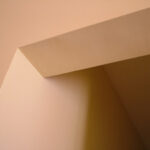Six years ago when we decided to build the “house of our dreams”, we considered a number of construction options. The house we lived in at that time was plagued with moisture problems in the basement, so we were determined to avoid that problem if at all possible.
Many people in our area were going with wood basements. However, when we heard that they might not last longer than 40-50 years, it didn’t seem like a very good investment to us. In the end we decided on Insulated Concrete Foam (ICF) construction, and we have not been sorry.
Insulated Concrete Foam houses are actually made out of Styrofoam-like blocks. We were able to put the blocks together ourselves, which was kind of a fun challenge. There is a lot of rebar in ICF houses, both horizontally and vertically within the blocks. According the manufacturer’s manual we followed, there were three different “levels” of rebar that could be built into the construction. One was for if your house was over an earthquake fault line, one was for a medium-risk area, and one was for a geographic area with a low earthquake risk.
Even though we lived in Michigan, where there are few earthquakes or worries about them, we went for the strongest type of construction. That meant a lot of rebar went inside those Styrofoam walls, and it all had to be wired together. I remember spending one whole day cutting rebar with a chop saw. (Later on I found out we could have ordered it pre-cut, but oh well.)
Once the rebar was inside the Styrofoam blocks. it was time for cement to be poured into the cavities in the blocks. The blocks had to be very straight, level and well-braced before this could happen, so we spent a few days with plumb lines and other such things. Then we had a pumper truck come from over an hour away (our house was out in the boonies, and pumper trucks are most easily found in large cities).
The day of the pour was a very exciting day for us, although it almost became a disaster. In the afternoon, as we were nearing the end of the project, a torrential rainstorm moved into the area. There was incredibly loud thunder and tremendous bolts of lightning. The gentleman operating the pumper truck looked like a brave and rather hardy soul, but he wasn’t about to keep operating that rig with the boom stuck way into the sky. So everything had to halt for an hour or two until the storm cleared. At one point there was doubt as to whether or not we could finish before dark, or if we would have to pay the pumper truck to come back yet another day. But in the end the job was finished, and we were very thankful.
There are some real idiosyncrasies with ICF construction, as we found out during the process. We had to purchase some extra tools to put the electrical wiring inside the Styrofoam blocks. We also had to purchase special equipment to attach siding to the blocks.
At the start of the project, we had not planned on finishing the basement for quite some time. However, the building inspector said we must have drywall over the Styrofoam blocks for safety reasons, and that also it must be mudded. Before we could put drywall on, we had to install the electrical, and once we had done all that, we decided to finish the basement.
That was one of several reasons our house cost more than we had planned on. The ICF contractor told us that we could build an ICF house for the same price as conventional construction, but with the project all said and done, we would have to dispute that claim. It seemed like it did cost 10-20% more due to the nature of the construction. However, because our basement is so comfortable and dry, the appraiser classified it as living space and upped the value of the property.
We have really enjoyed the ICF construction. The house is so quiet and warm. Our house is back in the woods, and one of our friends got a bullet through their wall during deer season, but we don’t worry too much about that. A bullet might get through a window, but never a wall. If I was building a house all over again, I would go with ICF construction in spite of whatever additional costs there might be. We like it that much, and that’s about the best compliment we can give.


